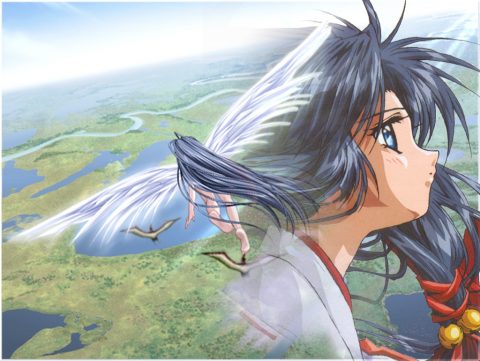"Golden Kamuy" is now a huge hit, and in 2016 it won the Manga Taisho Award. In fact, in recent years, there have been almost no manga that don't have a romance element at the Manga Taisho Awards. Golden Kamuy is packed with many other fascinating elements besides romance. One of these, which we'll be introducing today, is Ainu food. It appears frequently in the story and is one of the charms of the work. Incidentally, "hinna" is an Ainu word that expresses gratitude for a meal. Enjoy Ainu food that is sometimes beautiful, sometimes grotesque, but also delicious!
The First Squirrel to Have Chitatap
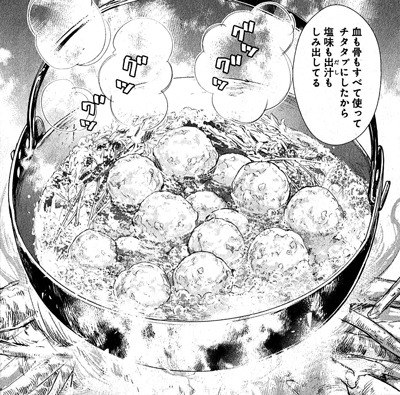
Source: Golden Kamuy © Satoru Noda/Shueisha, Golden Kamuy Production Committee
In "Golden Kamuy," the first squirrel to have chitatap. Chitatap means "that which we carve," referring to the act of chopping. Asirpa fed raw squirrel brains to Sugimoto, but perhaps she didn't think they looked very appetizing. He makes ohau (soup) with meatballs made from chopped squirrel. The flavoring is bukusakina (double jasmine). Bukusakina is said to be the wild vegetable that pairs best with meat, doubling the flavor of the meat. Sugimoto eats this and it is a blissful meal, which is also the scene where he says hinna for the first time.
Rabbit Hotpot: A Perfect Pairing with Miso
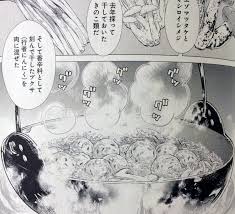
Source: Golden Kamuy © Noda Satoru / Shueisha, Golden Kamuy Production Committee
Sugimoto and his comrades caught a rabbit. Since there wasn't much edible part of it considering its size, they decided to make it into chitatap. They also peeled the skin off the ear cartilage and made chitatap along with the innards and meat. He mixed the meat with Siberian matsutake mushrooms, white shiitake mushrooms, and buksa (wild garlic) as a spice to make a stew. Sugimoto tasted it and commented that it was lighter than the squirrel's. Then he remembered miso. He recommended it to Asirpa, saying it would go well with miso, but Asirpa, having never seen miso before, rejected it, calling it osoma (poop). Sugimoto thoroughly enjoyed the rabbit hotpot mixed with miso.
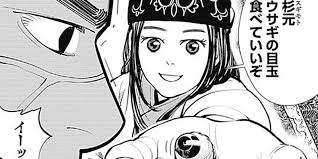
Source: Golden Kamuy © Noda Satoru / Shueisha, Golden Kamuy Production Committee
By the way, this is the first time Sugimoto has eaten a raw rabbit's eye. Apparently, it's an honorable meal reserved for the person who killed the prey.
Kajika Broth Kinaohau
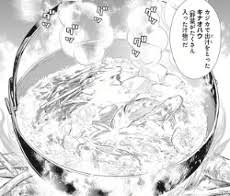
Source: Golden Kamuy © Noda Satoru / Shueisha, Golden Kamuy Production Committee
We set up a trap and captured plenty of Hokkaido sculpins. Winter sculpins are fatty and delicious. Asirpa's grandmother cooked these fish for us. A soup containing daikon radish, carrots, potatoes, spinach, kelp, and unglazed grilled sculpin. It was a kinaohau (soup with lots of vegetables) in sculpin broth. In the Ainu culture, people share what they receive with the spirits that reside behind their necks. Sugimoto made sure to share with his own spirit as well. He enjoyed it together with the grilled sculpin that Asirpa had made alongside him. Sugimoto suggested adding miso, but Asirpa flatly refused.
The Forgetful God: Otter
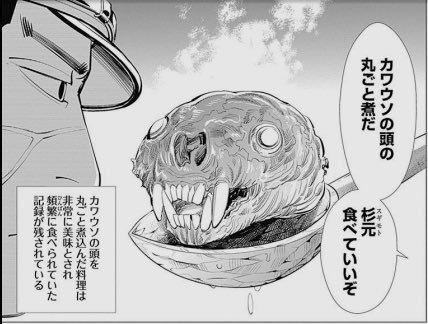
Source: Golden Kamuy © Noda Satoru / Shueisha, Golden Kamuy Production Committee
Asirpa kills an otter with a poisoned arrow. Apparently, the brains are delicious eaten raw with salt, but since she used a poisoned arrow, they require cooking, so that's on hold. In the meantime, she makes otter stew. Otter meat, dried burdock root, and lily of the valley. Apparently, animal meat goes well with root vegetables. Sugimoto ate the meat, saying that the fat was melt-in-your-mouth, not too heavy, and that it had a refined flavor. At that time, Asirpa suggested that he try a whole boiled otter head. There are also descriptions that describe it as being very delicious, so it seems that it was eaten quite frequently.
Venison Course Meal
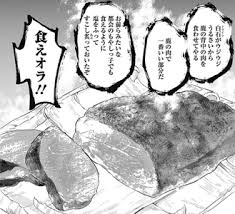
Source: Golden Kamuy © Noda Satoru / Shueisha, Golden Kamuy Production Committee
Sugimoto, seeing himself as a wounded deer, was unable to shoot it. Asirpa delivered the final blow. "The meat of a wounded prey runs away, and tastes bad, especially the liver," she said, feeding Sugimoto the first dish: raw deer liver. As it was Sugimoto's first time eating raw liver, he wasn't sure if the flavor had gone bad. Afterwards, they returned to the hut and started with the second dish, deer brains. As always, they had these raw. The third dish was deer lungs, which of course were also raw. The fourth dish was seuri, a dish of deer organs smothered in soy sauce. Sugimoto and Shiraishi wanted to eat meat, so they brought out the back part of the deer, which is said to be the best part of deer meat. They lightly grilled this. It was apparently delicious, and everyone was having a blast. It was a night where the alcohol flowed well.
In some regions, it's called Kamui (divine) Seal Stew
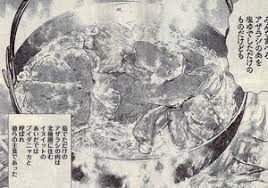
Source: Golden Kamuy © Noda Satoru / Shueisha, Golden Kamuy Production Committee
Ashirpa kills a tokkari (seal) with a stick. While it's not considered a kamuy because it's rare in Hidaka, in Sakhalin it is revered as important as a brown bear. Of course, the brain is eaten raw, while the meat, liver, and lungs are stewed. But then they run out of lily of the valley and end up stewing the food without anything to mask the smell, to Asirpa's dismay. It turns out to be boiled seal in salt water. Seal has a strong smell of blood, so something to mask the smell is necessary, but Sugimoto and the others enjoy it. It tastes like a cross between fish and beef, and Asirpa smiles with pride. Incidentally, boiled seal in salt water is called buidanyaka by the Inuit who live in the Arctic, and is their staple food.
Ainu Food
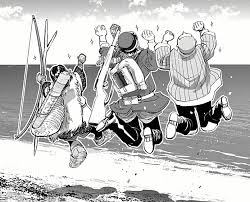
Source: Golden Kamuy © Satoru Noda / Shueisha, Golden Kamuy Production Committee
Their original diet consisted of simple preparations such as raw, stewed, or grilled food, and they used readily available wild vegetables as seasonings. However, it is said that there were regional variations, possibly due to the Ainu's permission to intermarry with other ethnic groups, resulting in some degree of cultural mingling. Even today, the culture of eating deer and wild boar as game meat remains in Japan. If you have the opportunity, please enjoy it. You may be able to get a taste of their culture.




